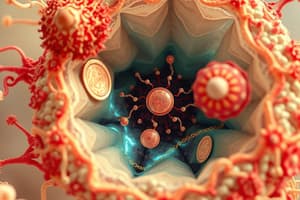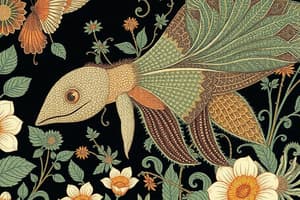Podcast
Questions and Answers
Which characteristic is NOT shared by all living organisms?
Which characteristic is NOT shared by all living organisms?
- Photosynthesis (correct)
- Nutrition
- Growth and development
- Respiration
All fungi can carry out photosynthesis.
All fungi can carry out photosynthesis.
False (B)
What is the primary carbohydrate storage form in animals?
What is the primary carbohydrate storage form in animals?
glycogen
Plants store carbohydrates as ______ or sucrose.
Plants store carbohydrates as ______ or sucrose.
Match each eukaryotic organism to its characteristic:
Match each eukaryotic organism to its characteristic:
Which organism is responsible for causing malaria?
Which organism is responsible for causing malaria?
Animals are unicellular organisms.
Animals are unicellular organisms.
What is the body structure of fungi primarily composed of?
What is the body structure of fungi primarily composed of?
Which of the following structures is NOT found in prokaryotic organisms such as bacteria?
Which of the following structures is NOT found in prokaryotic organisms such as bacteria?
All bacteria can perform photosynthesis.
All bacteria can perform photosynthesis.
What is the term used to describe disease-causing microorganisms?
What is the term used to describe disease-causing microorganisms?
Viruses can only reproduce inside __________ cells.
Viruses can only reproduce inside __________ cells.
Match the following examples with the correct type of pathogen:
Match the following examples with the correct type of pathogen:
Flashcards are hidden until you start studying
Study Notes
Characteristics of Living Organisms
- Require nutrition to maintain life processes
- Respiration is essential for energy production
- Excrete waste to eliminate harmful by-products
- Respond to environmental stimuli for survival
- Movement is a key feature for many organisms
- Control of internal conditions (homeostasis) is crucial for stability
- Reproduction ensures the continuation of the species
- Growth and development signify life progression
Common Features of Eukaryotic Organisms
Plants
- Multicellular organisms with chloroplasts for photosynthesis
- Cell walls made of cellulose
- Store carbohydrates as starch or sucrose
- Examples: cereal (maize) and herbaceous legumes (peas, beans)
Animals
- Multicellular without chloroplasts; unable to perform photosynthesis
- Lack cell walls, allowing for diverse movement
- Often possess nervous coordination for response to stimuli
- Store carbohydrates primarily as glycogen
- Examples: mammals (humans) and insects (housefly, mosquito)
Fungi
- Cannot perform photosynthesis; feed through saprotrophic nutrition
- Body typically organized into mycelium composed of hyphae (thread-like structures)
- Cell walls made of chitin; may store carbohydrates as glycogen
- Examples: Mucor (fungal structure) and yeast (single-celled)
Protoctists
- Microscopic, often single-celled organisms with diverse features
- Some resemble animal cells (e.g., Amoeba), while others resemble plant cells (e.g., Chlorella)
- Pathogenic example includes Plasmodium, the malaria-causing organism
Common Features of Prokaryotic Organisms
Bacteria
- Microscopic single-celled organisms with a cell wall and membrane
- Contain cytoplasm and plasmids, but lack a nucleus
- Possess a circular chromosome of DNA
- Many feed on living or dead organisms, some can photosynthesize
- Examples: Lactobacillus bulgaricus (yoghurt production) and Pneumococcus (causes pneumonia)
Pathogens
- Pathogens include fungi, bacteria, protoctists, and viruses
- Viruses are non-living entities that reproduce only inside living cells
- Smaller than bacteria with a protein coat and nucleic acid (DNA or RNA)
- Examples: tobacco mosaic virus (affects tobacco plants), influenza virus (causes flu), HIV (causes AIDS)
Studying That Suits You
Use AI to generate personalized quizzes and flashcards to suit your learning preferences.




